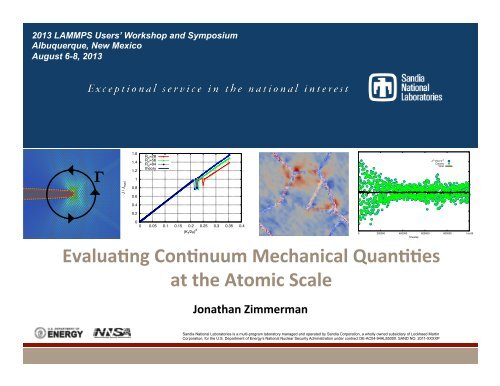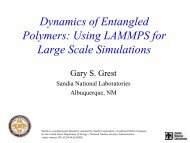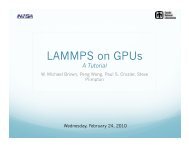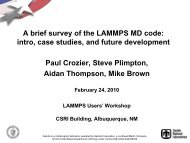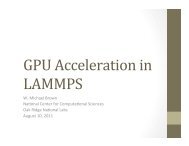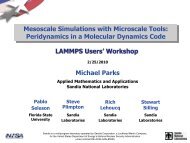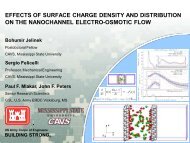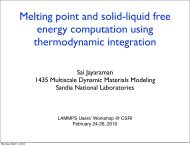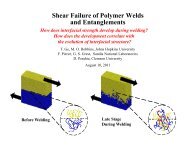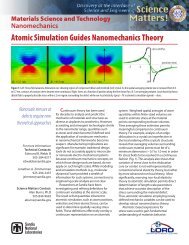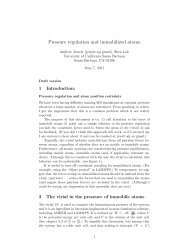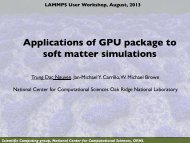Evaluating Continuum Mechanical Quantities at the ... - Lammps
Evaluating Continuum Mechanical Quantities at the ... - Lammps
Evaluating Continuum Mechanical Quantities at the ... - Lammps
- No tags were found...
Create successful ePaper yourself
Turn your PDF publications into a flip-book with our unique Google optimized e-Paper software.
2013 LAMMPS Users’ Workshop and SymposiumAlbuquerque, New MexicoAugust 6-8, 2013Γ1Photos placed in horizontal position0.8with even amount of white space0.6between photos and 0.4 headerJ / J nucl1.61.41.2R o =28R o =56R o =84<strong>the</strong>ory,-.*,,!/0123!%#&!%#%!%#$!%!"#'!"#&7 8) 91:)9; ?@AB4.42C0.2!"#%00 0.05 0.1 0.15 0.2 0.25 0.3 0.35 0.4(K I /2µ) 2Evalua&ng Con&nuum <strong>Mechanical</strong> Quan&&es <strong>at</strong> <strong>the</strong> Atomic Scale Jon<strong>at</strong>han Zimmerman !"#$!"!( !$((((( !%((((( !&((((( !'((((( !)*+(&-45*,-*6Sandia N<strong>at</strong>ional Labor<strong>at</strong>ories is a multi-program labor<strong>at</strong>ory managed and oper<strong>at</strong>ed by Sandia Corpor<strong>at</strong>ion, a wholly owned subsidiary of Lockheed MartinCorpor<strong>at</strong>ion, for <strong>the</strong> U.S. Department of Energy’s N<strong>at</strong>ional Nuclear Security Administr<strong>at</strong>ion under contract DE-AC04-94AL85000. SAND NO. 2011-XXXXP
Motiv<strong>at</strong>ion: <strong>Continuum</strong> mechanics <strong>at</strong> <strong>the</strong> nanoscaleM<strong>at</strong>erial deform<strong>at</strong>ion and failure occurs <strong>at</strong> various length scales:• Brittle and ductile fracture• Disloc<strong>at</strong>ion activity• Grain boundary sliding• Stiction, friction and wear(Pferner; 1999)(Bul<strong>at</strong>ov, Tang& Zbib; 2001 )(Boyce; 2012 )<strong>Continuum</strong> mechanics-based models to predict failure have been veryeffective <strong>at</strong> various length scales (10 -4 – 10 2 m) but can/should <strong>the</strong>y work <strong>at</strong><strong>the</strong> nanoscale?Our premise:• Define consistent fields from molecular simul<strong>at</strong>ion• <strong>Continuum</strong> <strong>the</strong>orynanoscaleresultsFigure 7. A cross-sectional SEM image of several voids and cavities <strong>at</strong> different length scales in a single neckedtensile bar. Contrast is due to electron channeling, which provides details on <strong>the</strong> subgrain morphology. Toobtain this image, a backsc<strong>at</strong>tered electron detector was used with a 15 keV electron beam <strong>at</strong> a working distanceI.e. first connect <strong>at</strong>omistics to continuum fields in a manner of 4 consistent mm. withbalance laws, <strong>the</strong>n use continuum <strong>the</strong>ory to analyze <strong>the</strong> process.12
!Atomistic-<strong>Continuum</strong> formul<strong>at</strong>ion of R.J. Hardy!Hardy (Journal of Chemical Physics, 1982) -( ) = m # $ x # % x" x,tN&#=1( )( ) = m " v " # x " $ xp x,t( )N% 1(E 0( x,t) = -&2 m" v " # v " + $ " )'* + ( x" , x)"=1Applying <strong>the</strong>se expressions!to <strong>the</strong> sp<strong>at</strong>ial forms of <strong>the</strong> balance laws, e.g.v ˆ" x,t!yields an expression for <strong>the</strong> Cauchy stress tensor:!N%"=1"p"t = " "x # $ % &v ! ' v( )and separ<strong>at</strong>ing continuum-scale momentum flux from <strong>at</strong>omic motion,!( ) = # +1 , 2" x,t*,-( ) = v " ( t) # v( x,t)x " = 0["] ~ 1 V c" > 0v " p/#N NN!((x $% & f $% B $%( x)+ ( m $ v ˆ$ & v ˆ$ ) x $ # x$=1 % '$$=1linear momentum ( )Thermal variables (he<strong>at</strong> flux, temper<strong>at</strong>ure) are also part of this formul<strong>at</strong>ion.Now th<strong>at</strong> we have <strong>the</strong>se tools, wh<strong>at</strong> can we do with <strong>the</strong>m… ?.,/0 ,
Deform<strong>at</strong>ion of nanocrystalline Ta• Objective: Characterize <strong>the</strong> defects th<strong>at</strong> form during uniaxial tension of aNC-Ta thin film, and use continuum fields to connect <strong>the</strong>ir gener<strong>at</strong>ion tolocally “measured” critical stresses.• Simul<strong>at</strong>ion details:• EAM by Li et al. (Phys. Rev. B, 2003)• Simul<strong>at</strong>ions done with LAMMPS (http://lammps.sandia.gov)• Geometry: thin film of dimensions 34.5 nm x 34.5 nm x 7 nm• 3 columnar grains of size 20 nm with random orient<strong>at</strong>ions• Approxim<strong>at</strong>ely 464,000 <strong>at</strong>oms• Equilibr<strong>at</strong>ion via he<strong>at</strong>ing to 1700K for 200 ps,<strong>the</strong>n cooling to 300K for 200 ps,using a Nosé-Hoover <strong>the</strong>rmost<strong>at</strong>• Uniaxial stress applied <strong>at</strong> strain r<strong>at</strong>es 10 5 to 10 9 sec -1
M<strong>at</strong>erial frame version of Hardy formul<strong>at</strong>ionM<strong>at</strong>erial frame balance laws:Densities:Substitute densities into balance laws and do a lot of m<strong>at</strong>h…
Resulting variables
J-integral analysis for quasi-st<strong>at</strong>ic crack initi<strong>at</strong>ionJ =Quasi-st<strong>at</strong>ic analysis shows:"• p<strong>at</strong>h independency of J integral0• agreement with LEFM for Harmonic m<strong>at</strong>erial• fracture occurs when J = 2γ for m<strong>at</strong>erials offinite strength# S ! Nds = # ( W 0N $ F T ! P ! N)ds" 0J 1 /2!1.81.61.41.210.80.60.40.20-0.2Lennard-Jones: loop 0Lennard-Jones: loop 1Lennard-Jones: loop 2Lennard-Jones: loop 3Lennard-Jones: loop 4Harmonic: loop 0Harmonic: loop 1Harmonic: loop 2Harmonic: loop 3Harmonic: loop 40 0.2 0.4 0.6 0.8 1 1.2K I /K Ic
J-integral for ductile crack propag<strong>at</strong>ion[110][00-1]FCC Au• EAM potential by Foiles et al.(1986)• Emission of type partialedge disloc<strong>at</strong>ions along {111}planes• Form<strong>at</strong>ion of stacking faults• J Rice = 1.27 < J c = 1.95 [J/m 2 ][01-1] BCC Fe[100]• EAM potential by Simonelli etal. (1993)• Emission of type fulledge disloc<strong>at</strong>ions along {211}planes• No stacking faults• J Rice = 6.56 > J c = 2.87 [J/m 2 ]10
J-integral for ductile crack propag<strong>at</strong>ionJ / J nucl1.61.41.210.80.60.40.20R o =28R o =56R o =84<strong>the</strong>ory0 0.05 0.1 0.15 0.2 0.25 0.3 0.35 0.4(K I /2µ) 2FCC Au• Disloc<strong>at</strong>ion emission occurs <strong>at</strong> J = 1.25 J/m 2• After emission, J-integral exhibits a jump of0.29 J/m 2 , <strong>the</strong>n recovers.• Second disloc<strong>at</strong>ion emission occurs <strong>at</strong> amarginally higher J and also displays nearimmedi<strong>at</strong>erecovery.J/J nucl10.80.60.40.2Ro = 28Ro = 56Ro = 84<strong>the</strong>oryBCC Fe• Disloc<strong>at</strong>ion emission occurs <strong>at</strong> J = 3.42 J/m 2• After emission, J-integral exhibits a jump of0.20 J/m 2 ; J remains <strong>at</strong> it’s new, lower level.• Second disloc<strong>at</strong>ion emission occurs <strong>at</strong> asignificantly higher value of J = 3.78 J/m 2 .00 0.2 0.4 0.6 0.8 1 1.2 1.4(K I /2µ) 211
J-integral formul<strong>at</strong>ion <strong>at</strong> finite temper<strong>at</strong>ure At finite temper<strong>at</strong>ures, stress and deform<strong>at</strong>ion are conjug<strong>at</strong>es of <strong>the</strong> freeenergy. Thus, <strong>the</strong> J-integral must be defined as…J =% ( ! N " F T # P # N)ds = J = % ( ! N " H T # P # N)ds$ 0 Free energy Ψ is difficult to calcul<strong>at</strong>e directly. Instead, we choose toapproxim<strong>at</strong>e it with <strong>the</strong> Quasi-Harmonic (QH) approach:$ 0! " ! QH= # 0+ k BTV log%'&n$i=1!! ik BT We fur<strong>the</strong>r use <strong>the</strong> Local-Harmonic (LH) simplific<strong>at</strong>ion of QH th<strong>at</strong> depends ona localized (diagonal) version of <strong>the</strong> dynamical m<strong>at</strong>rix:! LH= " 0+ k BTV !##!log%%$ $ k BT&('3det( D LH )&('(*)D LH= 1 m! 2 "!u 0!u 0
J-Integral analysis for finite temper<strong>at</strong>urecrack initi<strong>at</strong>ion Using <strong>the</strong>rmaliz<strong>at</strong>ion of a sequence of minimized st<strong>at</strong>es with far field loading,we obtain fields th<strong>at</strong> show localiz<strong>at</strong>ion toge<strong>the</strong>r with <strong>the</strong>rmal noise:• Zero temper<strong>at</strong>ure annulus of <strong>at</strong>oms used to enforce LEFM BCs.• Fields are time-averaged over a period of 40 ps (10 5 samples).
J-Integral retains p<strong>at</strong>h independenceJ 1 /2 γ1.41.210.80.60.40.20-0.2T=100 loop 0T=100 loop 1T=100 loop 2T=100 loop 3T=100 loop 4T=300 loop 0T=300 loop 1T=300 loop 2T=300 loop 3T=300 loop 4LEFM0 0.2 0.4 0.6 0.8 1 1.2K I / K Ic• P<strong>at</strong>h independence <strong>at</strong> both 100 and 300K.• J decreases with increasing T due to <strong>the</strong>rmal compression reducingeffective stress intensity factor.
Concluding remarksThank you to:• Reese Jones*, Jeremy Templeton*• Jay Foulk, Alejandro Mota• Stephen Foiles, Aidan Thompson• Jay Oswald* (ASU), Ted Belytschko* (Northwestern)• Jeff Rickman (Lehigh)Public<strong>at</strong>ions:J.A. Zimmerman et al., Modelling Simul. M<strong>at</strong>er. Sci. Eng. (2004) 12 S319-S332J.A. Zimmerman, R.E. Jones and J.A. Templeton, J. Comput. Phys. (2010) 229 2364-2389R.E. Jones and J.A. Zimmerman, J. Mech. Phys. Solids (2010) 58 1318-1337R.E. Jones et al., J. Phys.: Condens. M<strong>at</strong>ter (2011) 23 015002J.A. Zimmerman and R.E. Jones, J. Phys.: Condens. M<strong>at</strong>ter (2013) 25 155402


